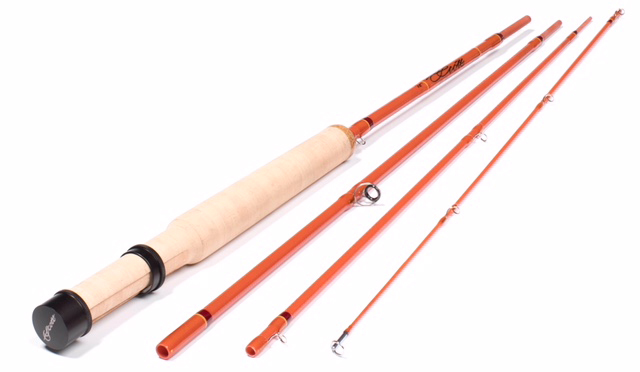
By Angling Trade Editor Kirk Deeter
The newly introduced, revised versions Scott Fly Rods’ F series rods are the best all-around production fiberglass fly rods I have ever fished, and it isn’t very close.
There, I said it. Disagree if you will, and I’ll be the first to admit that there are many others who are better-schooled aficionados of fiberglass rods that I ever will be but here’s my reasoning:
Remember that graphite supplanted fiberglass many years ago as the material of choice for large-scale production fly rods with good reason. It can offer a faster action, which yields better loops, more distance, improved accuracy and helps most (not all) recreational anglers cast better and be more effective on the water. It seemed to me that those of us who reserved some sentimental corners of our hearts for fiberglass did so for one of three main reasons. 1) We like the classic, slow action that we can feel in the grip (which actually helps to hone the instinctive timing of a casting stroke); 2) Fiberglass rods are often more affordable than their high-modulus graphite counterparts; and 3) Fiberglass is particularly fun to fish on small streams where smaller trout tend to prevail, and the right fiberglass rod can make an 8-inch brookie or cutthroat feel like Moby Dick. Well, not really, but you get my drift.
And fiberglass rods are often aesthetically beautiful. Some of the models I’ve seen introduced over the past decade, especially imports, are absolutely gorgeous. But for me it all reverts to “action” and being in tune with the small stream environment, making slingshot micro-casts at native or wild fish with dry flies. I am a sucker for the solitude, the improvisation, and the intimacy of fishing in those situations where a 15-foot cast is considered the long bomb. That’s my answer to the “if you had one day to fish anywhere” question, and I’m sticking to it.
I have always felt that Scott made supreme “intuitive action” rods, and I think the company has spent more time and effort designing and building rods in the oft-under-appreciated niche of fiberglass than any other major/production rod manufacturer. That’s abundantly obvious for any angler who picks up one of the new persimmon-colored “F” series rods ($695). I’ve spent the past month noodling with a 6’-2” 2-weight model (which I think is the honey model in the new lineup), first on the Baldwin River and Middle Branch of the Pere Marquette in Michigan, and more recently on the high-altitude creeks in Colorado. The rod is actually entertaining. It has a full flex and medium recovery, which puts me right in tune with the casting stroke, especially under 20 feet, and it answers the bell when I want to deviate from the script with a sideways roll-cast, or a bow-and-arrow flick.
In recent years, I have seen a number of iterations of fiberglass rods that lean toward faster actions to facilitate casting distance and fish-fighting heft. Which is fine. Wonderful, in fact, especially so you won’t find yourself tied into an 18-incher feeling like you brought a knife to the gunfight.
But I say let fiberglass be fiberglass. Celebrate fiberglass for the material it is, and work your game around that. If a company pours the right amount of effort into designing the right tapers that match well with modern fly lines—as Scott clearly has done in this case—there’s no reason why a fiberglass rod cannot be a top-line, “A-list” tool for the serious angler. What Scott has done here is smooth out some of the bulk and rough edges (noticeable only now if you match cast the new F rod against the original F, which I did, 2-weight v. 2-weight… the original F is, incidentally, what I would still rank second) and made a lighter-casting, easier loading, more accurate rod, without sacrificing any of the “soul” and “essence” of fishing fiberglass in the first place. It’s an extremely fine line to walk from a design and production standpoint, but I think Scott pulled it off with aplomb.
At nearly $700, the cost advantage of fiberglass in this case goes out the window. And there are and will be plenty of anglers who love graphite for its inherent advantages, will apply that to any small stream and never look back. Trout Unlimited digital editor Chris Hunt, for example, just wrote this about the new Dart series from Sage, and I’m certainly not here to disagree with him. Whatever flips your switch… it’s all good.
What I am saying is that Scott upped the game in the fiberglass realm, moving the material well out of being a “novelty” and there are plenty of angler consumers, like myself, who, once they fish the new F, will respect fiberglass even more. And some won’t consider fishing their favorite little brookie or cutthroat streams any other way.




2 Comments
Thanks for your report .I got to fish the 5’8″ 4pc. 3wt. a couple of days ago .In close with a size 14 dry dropper combo it was a little clunky cause of the beadhead after i got about 5′ of fly line out to over 30′ she cast some beautiful loops and roll casted that distance with little effort.This rod blows the old F2 6′ 2 wt. away.I was using a old SA mastery series trout DT. 3 also fished a size 16 elk hair caddis and had no trouble landing a 14″ cutt with this little rod .Iove the 5’8″ great pack rod.I also got to cast the F 6’6″ and compare it with my F2 but to close to call need to fish one.Anyway they really have improved the looks and workmanship over the F2’s ……..Aurelio
Fiberglass for big fish. I’ve landed two very big trout one 6lbs and one 4 1/2lbs on a fiberglass rod in heavy current. I have hooked up with large bites before from same waters on long graphites but fish broke off. Fiberglass is soft and forgiving.